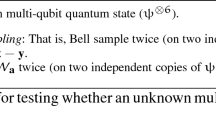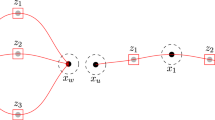Abstract
We prove that local random quantum circuits acting on n qubits composed of O(t 10 n 2) many nearest neighbor two-qubit gates form an approximate unitary t-design. Previously it was unknown whether random quantum circuits were a t-design for any t > 3. The proof is based on an interplay of techniques from quantum many-body theory, representation theory, and the theory of Markov chains. In particular we employ a result of Nachtergaele for lower bounding the spectral gap of frustration-free quantum local Hamiltonians; a quasi-orthogonality property of permutation matrices; a result of Oliveira which extends to the unitary group the path-coupling method for bounding the mixing time of random walks; and a result of Bourgain and Gamburd showing that dense subgroups of the special unitary group, composed of elements with algebraic entries, are ∞-copy tensor-product expanders. We also consider pseudo-randomness properties of local random quantum circuits of small depth and prove that circuits of depth O(t 10 n) constitute a quantum t-copy tensor-product expander. The proof also rests on techniques from quantum many-body theory, in particular on the detectability lemma of Aharonov, Arad, Landau, and Vazirani. We give applications of the results to cryptography, equilibration of closed quantum dynamics, and the generation of topological order. In particular we show the following pseudo-randomness property of generic quantum circuits: Almost every circuit U of size O(n k) on n qubits cannot be distinguished from a Haar uniform unitary by circuits of size O(n (k-9)/11) that are given oracle access to U.
Similar content being viewed by others
References
Abeyesinghe A., Devetak I., Hayden P., Winter A.: The mother of all protocols: restructuring quantum information’s family tree. Proc. R. Soc. A 465(2108), 2537–2563 (2009) arXiv:quant-ph/0606225
Hayden P., Shor P.W., Leung D.W., Winter A.J.: Randomizing quantum states: constructions and applications. Commun. Math. Phys. 250, 371–391 (2004) arXiv:quant-ph/0307104
Sen, P.: Random measurement bases, quantum state distinction and applications to the hidden subgroup problem. In: IEEE Conference on Computational omplexity, pp. 274–287 (2006). arXiv:quant-ph/0512085
Knill, E.: Approximation by quantum circuits (1995). arXiv:quant-ph/9508006
Tóth G., García-Ripoll J.J.: Efficient algorithm for multiqudit twirling for ensemble quantum computation. Phys. Rev. A 75, 042311 (2007) arXiv:quant-ph/0609052
Dankert C., Cleve R., Emerson J., Livine E.: Exact and approximate unitary 2-designs and their application to fidelity estimation. Phys. Rev. A 80, 012304 (2009) arXiv:quant-ph/0606161
Gross, D., Audenaert, K., Eisert, J.: Evenly distributed unitaries: on the structure of unitary designs. J. Math. Phys. 48, 052104 (2007). arXiv:quant-ph/0611002
Emerson, J., Livine, E., Lloyd, S.: Convergence conditions for random quantum circuits. Phys. Rev. A 72, 060302 (2005). arXiv:quant-ph/0503210
Oliveira, R., Dahlsten, O.C.O., Plenio, M.B.: Efficient generation of generic entanglement. Phys. Rev. Lett. 98, 130502 (2007). arXiv:quant-ph/0605126
Dahlsten O.C.O., Oliveira R., Plenio M.B.: The emergence of typical entanglement in two-party random processes. J. Phys. A: Math. Theor. 40(28), 8081–8108 (2007) arXiv:quant-ph/0701125
Harrow A., Low R.: Random quantum circuits are approximate 2-designs. Commun. Math. Phys. 291, 257–302 (2009) arXiv:0802.1919
Diniz I., Jonathan D.: Comment on “Random Quantum Circuits are Approximate 2-designs”. Commun. Math. Phys. 304, 281–293 (2011) arXiv:1006.4202
Arnaud L., Braun D.: Efficiency of producing random unitary matrices with quantum circuits. Phys. Rev. A 78, 062329 (2008) arXiv:0807.0775
Hayden P., Preskill J.: Black holes as mirrors: quantum information in random subsystems. JHEP 0709, 120 (2007) arXiv:0708.4025
Žnidarič M.: Exact convergence times for generation of random bipartite entanglement. Phys. Rev. A 78, 032324 (2008) arXiv:0809.0554
Harrow, A.W., Low, R.A.: Efficient quantum tensor product expanders and k-designs. In: Proceedings of APPROX-RANDOM, volume 5687 of LNCS, pp. 548–561. Springer (2009). arXiv:0811.2597
Roy A., Scott A.J.: Unitary designs and codes. Des. Codes Cryptogr. 53, 13–31 (2009) arXiv:0809.3813
Brown W.G., Viola L.: Convergence rates for arbitrary statistical moments of random quantum circuits. Phys. Rev. Lett. 104, 250501 (2010). arXiv:0910.0913
Brandao F.G.S.L., Horodecki M.: Exponential quantum speed-ups are generic. Quantum Inf. Comput. 13, 0901–0924 (2013) arXiv:1010.3654
Emerson J., Weinstein Y.S., Saraceno M., Lloyd S., Cory D.G.: Pseudo-random unitary operators for quantum information processing. Science 302(5653), 2098–2100 (2003)
Hallgren, S., Harrow, A.W.: Superpolynomial speedups based on almost any quantum circuit. In: ICALP, volume 5125, pp. 782–795 (2008). arXiv:0805.0007
Low R.A.: Large deviation bounds for k-designs. Proc. R. Soc. A: Math. Phys. Eng. Sci. 465(2111), 3289–3308 (2009) arXiv:0903.5236
Brodsky A., Hoory S.: Simple permutations mix even better. Random Struct. Algorithms 32, 274–289 (2008) arXiv:math/0411098
Kaplan E., Naor M., Reingold O.: Derandomized constructions of k-wise (almost) independent permutations. Algorithmica 55, 113–133 (2009) (ECCC TR06-002)
Hastings M.B., Harrow A.W.: Classical and quantum tensor product expanders. Quantum Inf. Comput. 9(3&4), 336–360 (2009) arXiv:0804.0011
Low, R.A.: Pseudo-randomness and Learning in Quantum Computation. PhD thesis, University of Bristol (2010). arXiv:1006.5227
Kitaev, A.Y., Shen, A.H., Vyalyi, M.N.: Classical and Quantum Computation, volume 47 of Graduate Studies in Mathematics. AMS (2002)
Bourgain, J., Gamburd, A.: A spectral gap theorem in SU(d) (2011). arXiv:1108.6264
Shende, V.V., Bullock, S.S., Markov, I.L.: Synthesis of quantum-logic circuits. IEEE Trans. Comput.- Aided Design Integr. Circuits Syst. 25(6), 1000–1010 (2006). arXiv:quant-ph/0406176
Kassabov M.: Symmetric groups and expanders. Electron. Res. Announc. Am. Math. Soc. 11, 47–56 (2005) arXiv:math/0503204
Hoory S., Magen A., Myers S., Rackoff C.: Simple permutations mix well. Theor. Comput. Sci. 348(2), 251–261 (2005)
Zatloukal, K.: Improved bounds for k-tensor product expanders (2012) (in preparation)
Hayden P., Leung D.W., Winter A.: Aspects of generic entanglement. Commun. Math. Phys. 265(1), 95–117 (2006)
Bremner M.J., Mora C., Winter A.: Are random pure states useful for quantum computation?. Phys. Rev. Lett. 102, 190502 (2009) arXiv:00812.3001
Gross D., Flammia S.T., Eisert J.: Most quantum states are too entangled to be useful as computational resources. Phys. Rev. Lett. 102, 190501 (2009) arXiv:0810.4331
Aaronson, S.: The ten most annoying questions in quantum computing (2006) http://www.scottaaronson.com/blog/?p=112
Goldstein S., Lebowitz J.L., Tumulka R., Zanghi N.: Long-time behavior of macroscopic quantum systems: commentary accompanying the english translation of john von neumann’s 1929 article on the quantum ergodic theorem. Eur. Phys. J. 35, 173 (2010)
Linden N., Popescu S., Short A.J., Winter A.: Quantum mechanical evolution towards thermal equilibrium. Phys. Rev. E 79, 061103 (2009) arXiv:0812.2385
Cramer M., Eisert J.: A quantum central limit theorem for non-equilibrium systems: exact local relaxation of correlated states. New J. Phys. 12(5), 055020 (2010) arXiv:0911.2475
Gogolin C., Müller M.P., Eisert J.: Absence of thermalization in nonintegrable systems. Phys. Rev. Lett. 106, 040401 (2011) arXiv:1009.2493
Reimann P.: Foundation of statistical mechanics under experimentally realistic conditions. Phys. Rev. Lett. 101, 190403 (2008) arXiv:0810.3092
Vinayak, Znidaric, M.: Subsystem dynamics under random Hamiltonian evolution. J. Phys. A: Math. Theor. 45, 125204 (2012).arXiv:1107.6035. doi:10.1088/1751-8113/45/12/125204
Masanes L., Roncaglia A.J., Acin A.: The complexity of energy eigenstates as a mechanism for equilibration. Phys. Rev. E 87, 032137 (2013) arXiv:1108.0374
Brandão F.G.S.L., Ćwikliński P., Horodecki M., Horodecki P., Korbicz J., Mozrzymas M.: Convergence to equilibrium under a random hamiltonian. Phys. Rev. E 86, 031101 (2012) arXiv:1108.2985
Cramer M.: Thermalization under randomized local hamiltonians. New J. Phys. 14(5), 053051 (2012) arXiv:1112.5295
von Neumann J.: Beweis des ergodensatzes und des h-theorems in der neuen mechanik. Zeitschrift für Physik 57(1–2), 30–70 (1929)
Goldstein S., Lebowitz J.L., Tumulka R, Zanghì N: Canonical typicality. Phys. Rev. Lett. 96, 050403 (2006)
Trotzky S., Chen Y.-A., Flesch A., McCulloch I.P., Schollwöck U., Eisert J., Bloch I.: Probing the relaxation towards equilibrium in an isolated strongly correlated one-dimensional bose gas. Nat. Phys. 8(4), 325–330 (2012)
Bañuls M.C., Cirac J.I., Hastings M.B.: Strong and weak thermalization of infinite nonintegrable quantum systems. Phys. Rev. Lett. 106, 050405 (2011)
Susskind L.: Computational complexity and black hole horizons. Fortschr. Phys. 64(1), 24–43 (2016) arXiv:1402.5674
Wen X.-G.: Topological orders in rigid states. Int. J. Mod. Phys. 239, 050401 (1990)
Kitaev A.Y.: Fault-tolerant quantum computation by anyons. Ann. Phys. 303, 1 (2003) arXiv:quant-ph/9707021
Nayak C., Simon S.H., Stern A., Freedman M., Sarma S.D.: Non-Abelian anyons and topological quantum computation. Rev. Mod. Phys. 80, 1083 (2008) arXiv:0707.1889
Bravyi S., Hastings M.B., Verstraete F.: Lieb–Robinson bounds and the generation of correlations and topological quantum order. Phys. Rev. Lett. 97, 050401 (2006) arXiv:quant-ph/0603121
Chen X., Gu Z.-G., Wen X.-G.: Local unitary transformation, long-range quantum entanglement, wave function renormalization, and topological order. Phys. Rev. B 82, 1083 (2010) arXiv:1004.3835
Hastings M.B.: Topological order at non-zero temperature. Phys. Rev. Lett. 107, 210501 (2011) arXiv:1106.6026
Sekino Y., Susskind L.: Fast scramblers. J. High Energy Phys. 10, 065 (2008) arXiv:0808.2096
Lashkari, N., Stanford, D., Hastings,M., Osborne, T., Hayden, P.: Towards the fast scrambling conjecture J. High Energy Phys. 2013, 22 (2013)
Nachtergaele B.: The spectral gap for some spin chains with discrete symmetry breaking. Commun. Math. Phys. 175, 565–606 (1996) arXiv:cond-mat/9410110
Fannes M., Nachtergaele B., Werner R.: Finitely correlated states on quantum spin chains. Commun. Math. Phys. 144, 443–490 (1992)
Perez-Garcia D., Verstraete F., Wolf M.M., Cirac J.I.: Matrix product state representations. Quantum Inf. Comput. 7(5&6), 401–430 (2007) arXiv:quant-ph/0608197
Bubley, R., Dyer, M.E.: Path coupling: a technique for proving rapid mixing in Markov chains. In: Proceedings of the 38th IEEE Symposium on Foundations of Computer Science (FOCS), pp. 223–231 (1997)
Oliveira R.I.: On the convergence to equilibrium of Kac’s random walk on matrices. Ann. Appl. Probab. 19(3), 1200–1231 (2009) arXiv:0705.2253
Aharonov D., Arad I., Vazirani U., Landau Z.: The detectability lemma and its applications to quantum Hamiltonian complexity. New J. Phys. 13(11), 113043 (2011) arXiv:1011.3445
Damgard, I.B., Fehr, S., Salvail, L., Schaffner, C.: Cryptography in the bounded quantum-storage model. In: Proceedings of the 46th Annual IEEE Symposium on Foundations of Computer Science, FOCS ’05, pp. 449–458, Washington, DC, USA, 2005. IEEE Computer Society. arXiv:quant-ph/0508222.
Barenco A., Bennett C.H., Cleve R., DiVincenzo D.P., Margolus N., Shor P., Sleator T., Smolin J.A., Weinfurter H.: Elementary gates for quantum computation. Phys. Rev. A 52, 3457–3467 (1995) arXiv:quant-ph/9503016
Goodman, R., Wallach, N.R.: Representations and Invariants of the Classical Groups. Cambridge University Press, Cambridge (1998). http://www.math.rutgers.edu/~goodman/cuprepbook.html
Christandl, M.: The structure of bipartite quantum states: insights from group theory and cryptography. PhD thesis, University of Cambridge (2006). arXiv:quant-ph/0604183
Arnold, V.I., Krylov, A.L.: Uniform distribution of points on a sphere and some ergodic properties of solutions of linear ordinary differential equations in a complex domain. Sov. Math. Dokl. 148, 9–12 (1963)
Szarek T.: Feller processes on nonlocally compact spaces. Ann. Probab. 34(5), 1849–1863 (2006) arXiv:math/0512221
Szarek, T.: (2011) (private communication)
Harrow, A.W.: The church of the symmetric subspace (2013). arXiv:1308.6595
Bhatia, R.: Matrix Analysis, volume 169. Springer Science & Business Media, Berlin (1997)
Ambainis A., Bouda J., Winter A.: Nonmalleable encryption of quantum information. J. Math. Phys. 50(4), 042106 (2009) arXiv:0808.0353
Aharonov, D., Kitaev, A., Nisan, N.: Quantum circuits with mixed states. In: Proceedings of the thirtieth annual ACM symposium on Theory of computing, pp. 20–30. ACM (1998). arXiv:quant-ph/9806029
Milman, V.D., Schechtman, G.: Asymptotic theory of finite dimensional normed spaces. Lecture notes in mathematics. Springer, Berlin (1986)
Bernstein, E., Vazirani, U.: Quantum complexity theory. In: Proceedings of the 25th Annual ACM Symposium on the Theory of Computation (STOC), pp. 11–20. ACM Press, El Paso, Texas (1993)
Ledoux, M.: The Concentration of Measure Phenomenon. AMS Monographs, Providence (2001)
Kastoryano M.J., Temme K.: Quantum logarithmic Sobolev inequalities and rapid mixing. J. Math. Phys. 54, 052202 (2013) arXiv:1207.3261
Stolz, G.: An introduction to the mathematics of anderson localization. Contemp. Math. 552 (2011). arXiv:1104.2317
Harrow, A.W.: Applications of coherent classical communication and Schur duality to quantum information theory. PhD thesis, M.I.T., Cambridge, MA (2005). arXiv:quant-ph/0512255
Author information
Authors and Affiliations
Corresponding author
Additional information
Communicated by M. M. Wolf
Rights and permissions
About this article
Cite this article
Brandão, F.G.S.L., Harrow, A.W. & Horodecki, M. Local Random Quantum Circuits are Approximate Polynomial-Designs. Commun. Math. Phys. 346, 397–434 (2016). https://doi.org/10.1007/s00220-016-2706-8
Received:
Accepted:
Published:
Issue Date:
DOI: https://doi.org/10.1007/s00220-016-2706-8




